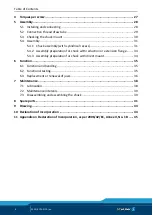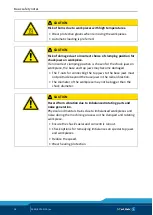
Basic safety notes
02.00|ROTA NCA |en
17
DANGER
Possible risk of fatal injury to operating personnel from clothing
or hair being caught on the lathe chuck and being dragged into
the machine
Loose clothing or long hair may become caught on projecting
parts of the lathe chuck and be drawn into the machine.
•
The machines and equipment must fulfill the minimum
requirements of the EC Machinery Directive; specifically, they
must have effective technical measures to protect against
potential mechanical hazards.
•
Always wear tight-fitting clothing and a hairnet when working
on the machine and the lathe chuck.
CAUTION
Danger of slipping and falling in case of dirty environment
where the chuck is used (e.g. by cooling lubricants or oil).
•
Ensure that the working environment is clean before starting
assembly and installation work.
•
Wear suitable safety shoes.
•
Follow the safety and accident-prevention regulations when
operating the chuck, especially when working with machine
tools and other technical equipment.
CAUTION
Danger of limbs being crushed by opening and closing of the
chuck jaws during manual loading and unloading or when
replacing moving parts.
•
Do not reach between the jaws.
•
Wear safety gloves.
•
Observe the safety and accident prevention regulations during
operation of the chuck, especially in connection with
machining centers and other technical equipment.
















































